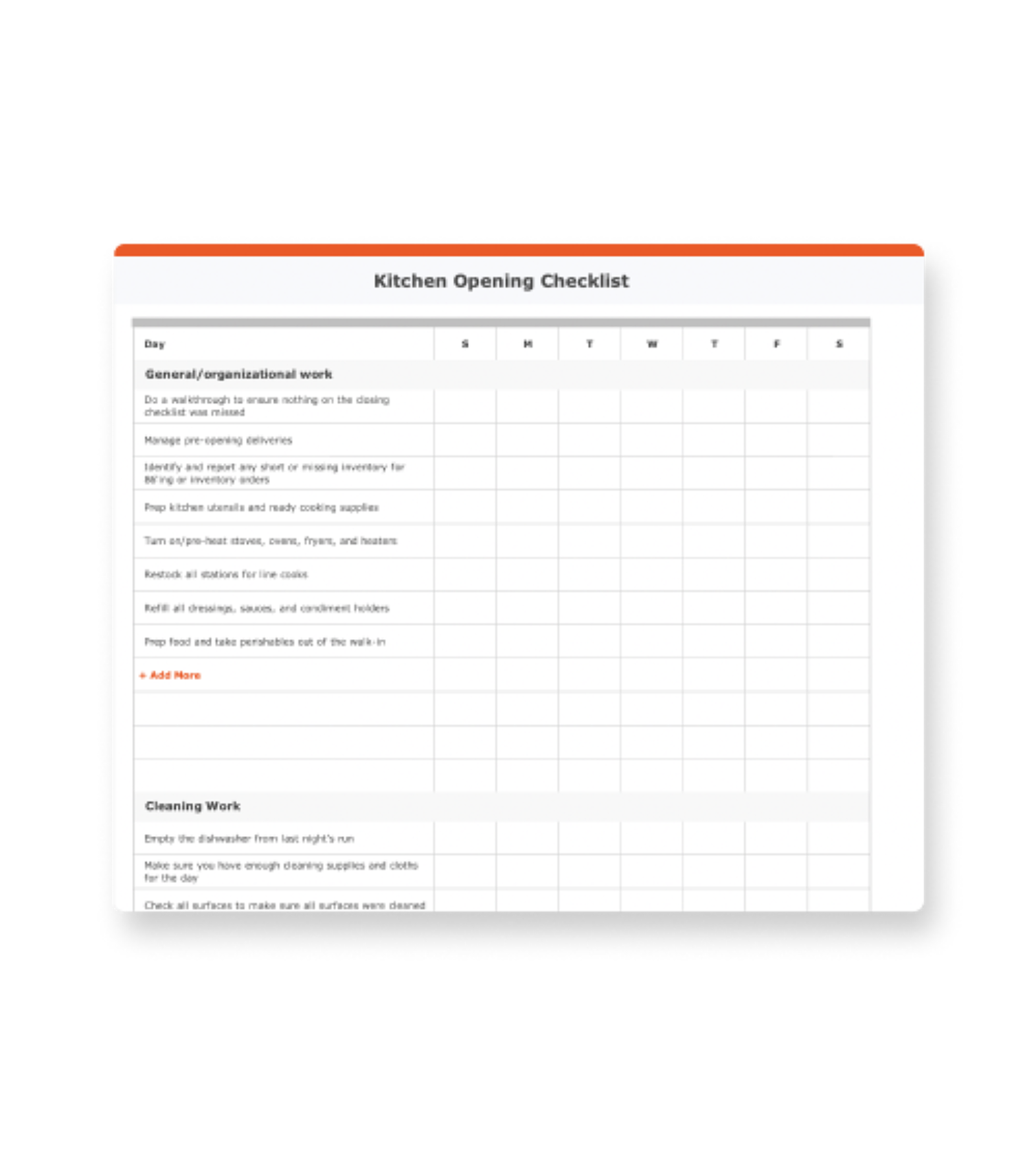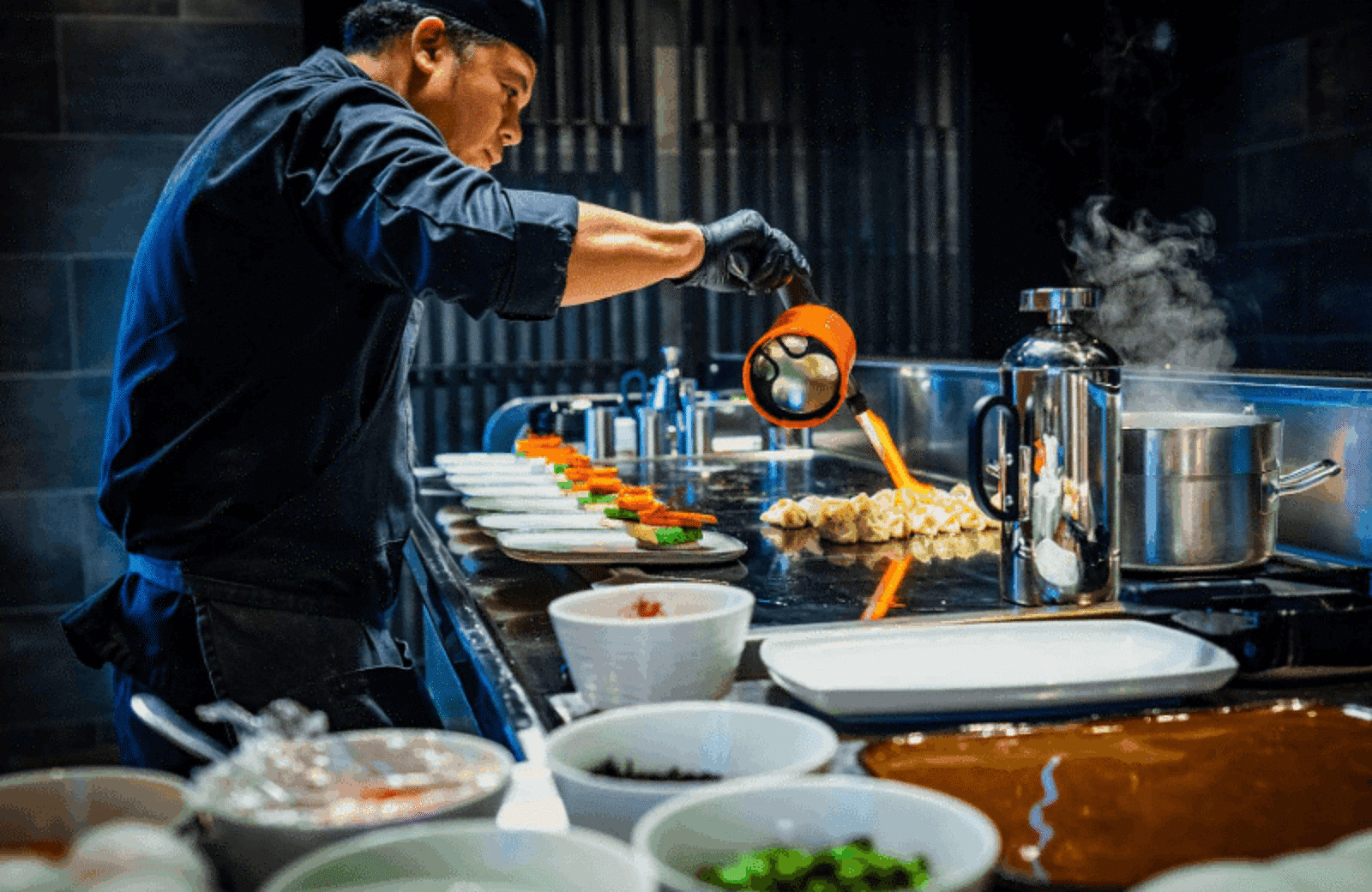
How to Build a Great Restaurant Kitchen Closing Checklist
Kitchen opening and closing checklists keep the back of house from descending into chaos. Download our opening and closing checklist template and build yours.

AJ BeltisAuthor


Kitchen Opening and Closing Checklist
Ensure your back of house runs like a well oiled machine with these customizable kitchen opening and closing checklists.
Get free downloadHow do kitchen checklists help restaurants run smoothly?
1. Good restaurant management involves clear employee expectations — and checklists are an easy way to communicate tasks to be done.
2. Documentation empowers new employees.
3. Restaurant kitchen mistakes happen, but checklists prevent most of them.
4. Kitchen checklists help employees easily share the work to be done.
Part of what makes restaurant work exciting is that even though the tasks may seem repetitive on paper — clean, prep, cook, serve, clean, inventory, payroll, and so on — every single day brings a different set of customers and a different set of challenges.
That’s why checklists are so crucial to keeping restaurants running smoothly. Prep lists, kitchen cleaning checklists, opening checklists, closing checklists, and side work checklists can be long and full of a wide range of tasks. It’s not always possible to do it all from memory.
Download our kitchen opening and closing checklist template, bulk it up with the opening closing procedures specific to your restaurant, and you’ll be ready to print it and share it with your kitchen staff.
Kitchen Opening and Closing Checklist
Ensure your back of house runs like a well oiled machine with these customizable kitchen opening and closing checklists.

You can also modify the template above to work as a front of house opening or closing checklist that includes things like cash register reconciliation, restocking napkins, wiping down the POS, and updating a manager log book.
Why Do Kitchen Checklists Matter?
There are so many closing tasks that go into closing down the restaurant kitchen at the end of a shift. It’s easy enough to say that closing is just about cleaning everything, turning everything off, and making sure everything is closed and locked, but keeping track of each task, large and small, is daunting — even if you’ve done it a million times.
And to get a kitchen up and running the next day, there’s a laundry list of opening tasks. New deliveries need to be put away and inventoried, ingredients need to be prepped, ovens need to be set to the right temperature, refrigerators and freezers must be checked to keep perishable foods safe, and rags need to be distributed — plus at least a dozen other cleaning tasks that keep the kitchen running smoothly and safely.
No one can keep it all in their head and get it done perfectly every time — which is why restaurant kitchen opening checklists and kitchen closing checklists are such an important grounding force in a back of house operation.
Good Restaurant Management Involves Clear Employee Expectations
As a restaurant owner or manager, it's your job to make employee duties as clear and simple as possible — that way, back of house employees can get their repetitive tasks done smoothly and focus their efforts on making delicious food for your guests, which remains one of the most important factors guests use to in choosing a restaurant.
And because it’s still challenging to find and retain great restaurant employees, it’s important to put in the effort to make working at your restaurant as enjoyable and rewarding as possible. The way to keep employees engaged at work is to create a supportive environment, implementing restaurant management strategies that ensure every employee knows what they need to do to succeed.
Restaurant consultant and employee trainer Tucker Bascom shared in a post that “In a restaurant, your team needs you to give them clearly defined outcomes that they are responsible for creating,” he said. “Your team needs you to show them what a job well done looks like,” he added. Checklists can be part of creating an empowered team.
Documentation Empowers New Employees
Clear, concise checklists are one of the most powerful forms of documentation in a restaurant. A restaurant lifer may be able to move through your opening and closing procedure with their eyes closed, but turnover continues to be a defining factor of the restaurant industry — so new people need clear documentation that explains your safety standards and how things are done in your businesses.
Shadowing a pro helps new employees get onboarded and learn the ropes, but restaurant kitchens are notoriously hectic, and most learners need a list to consult and use as they get used to working in the restaurant.
Restaurant Kitchen Mistakes Happen, but Checklists Prevent Most of Them
No one’s perfect, especially not after working a 12-hour shift in a 100-degree kitchen. Every restaurant has dealt with a forgotten frozen item left defrosting all night — a food safety and food waste disaster — or, at worst, a break-in or fire due to an unlocked door or an oven left on at the end of the day.
Ensuring that every employee uses a closing checklist and opening checklist at the end and beginning of their shifts can prevent all manner of mistakes and omissions.
Kitchen Checklists Help Kitchen Employees Share the Labor
Every day is different in a kitchen — is someone out sick? Huge party booked for lunch? Produce came late? — so having a concrete checklist of what needs to be done helps spread out the work. If a prep cook working on their list is in the weeds, they can just point to a few items and ask their peers for help.
Let’s move on to setting up your kitchen opening checklist and kitchen closing checklist. Download the template above and we’ll get started.
How to Set Up a Kitchen Opening or Closing Checklist
From walking through the kitchen to printing the list, here’s how to build your opening checklist.
Step 1: Identify the Tasks
Be the first to come in and watch your kitchen crew prepping the back of house in the morning and take note of their activities — and stay until after the last team member leaves, noting down everything they do after service is done.
Sit down with your back-of-house staff and have them tell you everything they do in the morning and at close. Talk to your connections in the industry and have them explain what they do to open and close their kitchen.
Opening checklists tend to emphasize cleanliness and setting up the team for efficiency during service.
Some common restaurant kitchen opening checklist tasks include:
Identifying and reporting 86'ed ingredients (and menu items).
Handling pre-opening deliveries.
Gathering kitchen utensils and readying cooking supplies.
Turning on/pre-heating stoves, ovens, fryers, and salamanders.
Restocking ingredient stations for line cooks.
Prepping food and taking perishables out of the walk-in.
Closing checklists tend to have a stronger emphasis on health and safety. Because food is stored overnight and the premises are left unattended, simple missteps could lead to big problems. Leaving an oven or stove on or not shutting a refrigerator door tightly could damage your building or spoil your food.
Some common restaurant closing checklist tasks include:
Turning off all lights, ovens, grills, stoves, and hot surfaces.
Safely storing cooking utensils, glasses, and dishes.
Wrapping, dating, and storing all remaining food that can be used later.
Taking out the trash.
Sanitizing all surfaces and cleaning all floors.
Wiping down the kitchen display screen.
Running the dishwasher.
Cleaning large kitchen equipment like stovetops.
Turning on the alarm system and locking the door.
Once you've tracked everything that needs to be done, you'll have all the contents for your checklist. But where do you put them?
Step 2: Organize Your Tasks
Whether your kitchen is opened daily by one dedicated chef or it’s done by an assembly of cooks and support staff, it's beneficial to break up your kitchen checklist by section and task — or chronologically.
Go through the list of tasks and find common threads between line items. Bucket them together by priority, task relatedness, physical proximity, etc.
Step 3: Create and Print the Kitchen Opening and Closing Checklists
Once you have all of your to-do items organized, list them on an Excel sheet (like our kitchen opening and closing checklist template) and use that as your printable kitchen opening checklist. Decide whether you want to print the checklists separately or as one large checklist.
In order to cut back on printing costs, have the list laminated and have kitchen staff use dry-erase markers to track their progress through the list.
Alternately, print a stack of opening and closing checklists each week for staff to use and mark up with a pencil, pen, or sharpie.
Save a copy for your records to adjust and re-print when opening or closing procedures are changed.
Make sure you leave space at the bottom for comments and a signature by whoever did or reviewed the tasks, so errors and notes can be promptly followed up on.
Keep Kitchen Staff Organized and on Track with Kitchen Closing and Opening Checklists
A checklist can make a huge pile of tasks feel manageable. Download a kitchen opening and closing checklist template, customize it, print it out, and help your staff stay organized and engaged.
Back of House Management Guide and Resource Kit
This guide and resource kit will help you develop an efficient back of house management system to ensure quality and consistency in your restaurant’s kitchen.

Related Restaurant Equipment Resources
Is this article helpful?
DISCLAIMER: This information is provided for general informational purposes only, and publication does not constitute an endorsement. Toast does not warrant the accuracy or completeness of any information, text, graphics, links, or other items contained within this content. Toast does not guarantee you will achieve any specific results if you follow any advice herein. It may be advisable for you to consult with a professional such as a lawyer, accountant, or business advisor for advice specific to your situation.
Read More
Subscribe to On the Line
Sign up to get industry intel, advice, tools, and honest takes from real people tackling their restaurants’ greatest challenges.



